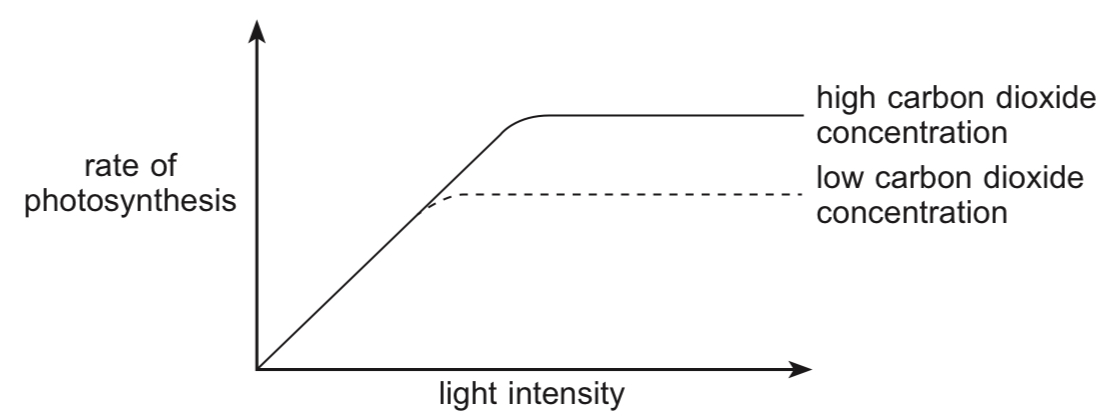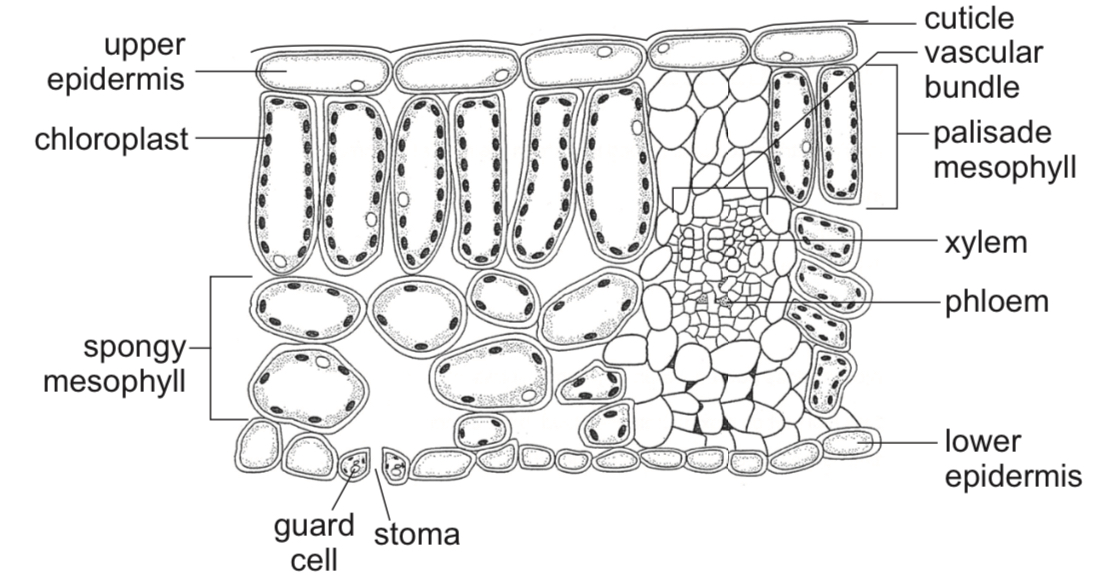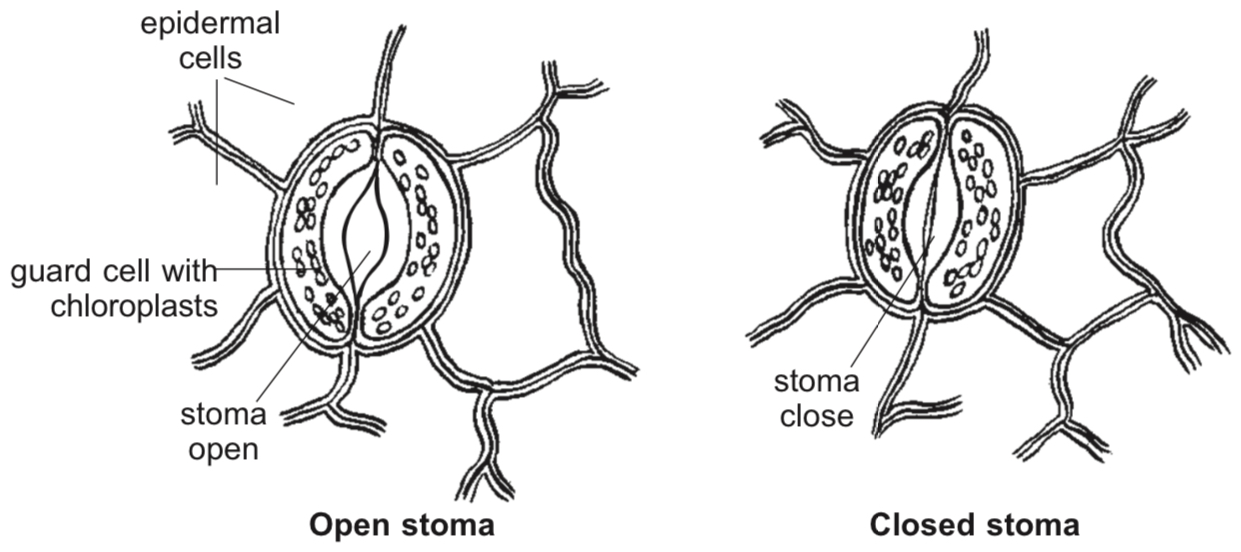Chapter 4 - Photosynthesis
Photosynthesis
Photosynthesis is the process by which plants convert carbon dioxide and water into sugars using sunlight as energy in the presence of chlorophyll.
Equation for photosynthesis:
6CO2 + 12H2O ——> C6H12O6 + 6O2 + 6H2O carbon dioxide + water
Photosynthesis is split into 2 stages: light-dependent stage and light-independent stage.
Light-dependent stage:
Light energy is absorbed by chlorophyll and used to split water into hydrogen and oxygen atoms in a process called photolysis.
The oxygen atoms combine to form oxygen gas which is a product of photosynthesis.
Other high-energy molecules are generated for use in the light-independent stage to convert carbon dioxide into glucose.
Light-independent stage:
The chemical energy stored during the light reactions as high-energy molecules is used in a series of reactions to convert carbon dioxide into carbohydrate.
Hydrogen from the light reactions is used as a reducing agent in the process.
The carbohydrate formed in this stage is converted to glucose and other carbohydrates by enzymes.
No light energy is required in this stage.
Factors that affect the Rate of Photosynthesis:
Light intensity, carbon dioxide concentration and temperature are limiting factors on the rate of photosynthesis.
At a constant temperature and carbon dioxide concentration, the rate of photosynthesis increases with increasing light intensity until it reaches a plateau.
When the plateau is reached, light is no longer the limiting factor in the reaction. The concentration of carbon dioxide becomes the limiting factor.
Increasing the concentration of carbon dioxide raises the plateau reached.
Increasing the temperature over a certain range has little effect at low light intensities but increases the rate of photosynthesis at high light intensities.

Both light and dark reactions involve enzymes which would be denatured at a high temperature.

Internal leaf structure
The diagram below shows the cross section of a dicotyledonous leaf as seen under a microscope:

The upper epidermis is a single layer of irregular, closely packed cells covered by a layer of waxy cuticle. The cuticle protects the epidermis and prevents excessive water loss through evaporation. It is transparent to allow sunlight to pass through. Epidermal cells contain no chloroplasts.
Palisade mesophyll cells are columnar in shape and closely packed. They contain a lot of chloroplasts to increase absorption of sunlight for photosynthesis.
Spongy mesophyll cells are irregular in shape with numerous intercellular air spaces around them to allow for fast diffusion of carbon dioxide, which enters the leaf through the stomata, to all photosynthetic cells. They contain fewer chloroplasts than palisade mesophyll cells. They are covered with a thin film of moisture so that carbon dioxide can dissolve in it.
Within the mesophyll layers are the vascular bundles containing xylem and phloem tissue. This brings the transport tissue into close contact with the photosynthetic tissue, allowing water and mineral salts to be distributed to the photosynthetic cells efficiently and food products to be brought to other parts of the plant.
The lower epidermis is also a single layer of closely-packed cells covered by a layer of waxy cuticle.
Guard cells are bean-shaped, chloroplast-containing cells located in the lower epidermis. They control the opening and closing of the stoma (plural: stomata), the gap between the guard cells. The stomata allow carbon dioxide to diffuse in, oxygen to diffuse out and water vapour to escape.
Role of Guard Cells:

Plants open their stomata during the day for carbon dioxide intake and close their stomata during the night to minimise water loss through transpiration.
Guard cells control the opening and closing of stomata through regulation of water potential within themselves.
Photosynthesis in guard cell chloroplasts provides the energy for the uptake of potassium ions into the cell.
This lowers the water potential within the guard cells, causing water to enter by osmosis.
Each guard cell has a thicker cellulose cell wall on the side surrounding the stomata, as compared to the side adjacent to neighbouring epidermal cells. When water enters the cell, the side away from the stoma, being thinner, expands more than the side framing the stoma. This causes the cells to become curved such that the stoma opens.
When there is excessive water loss, even during the day, the guard cells lose turgor and become flaccid, causing the stoma to close.
Intake of carbon dioxide
When carbon dioxide within the leaf is used up by photosynthesis, the concentration of carbon dioxide in the leaf becomes lower than that in atmospheric air.
Carbon dioxide diffuses into the intercellular air spaces of the spongy mesophyll layer through the stomatal openings.
The mesophyll cells exposed to the intercellular air spaces are covered by a thin film of water. Carbon dioxide dissolves in it and diffuses into the cells.
Intake of water
The vascular bundles in the stem pass through the petioles and enter the leaves.
Within the leaves, they branch throughout the mesophyll layers, forming leaf veins.
Water from the roots travels through the xylem vessels in the vascular bundles and enters the leaves.
Once out of the xylem vessels, water travels from cell to cell through osmosis.
 Knowt
Knowt
